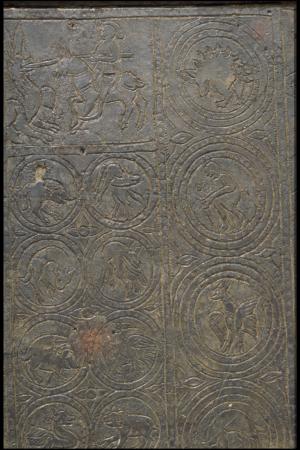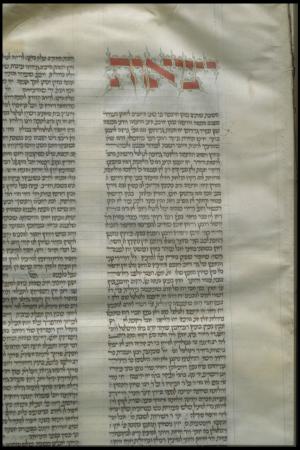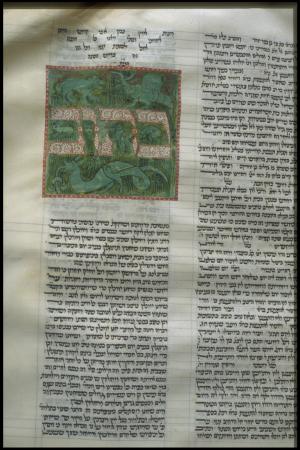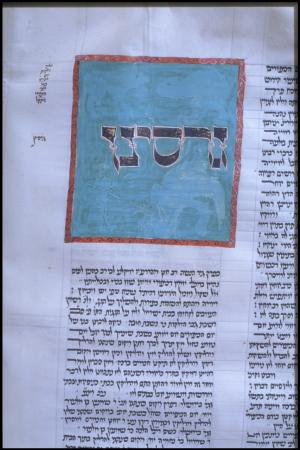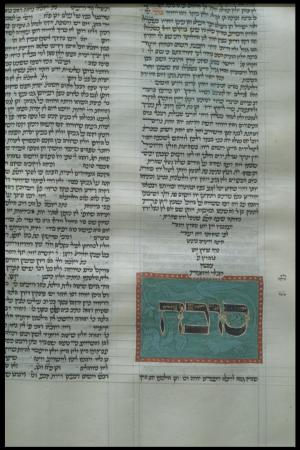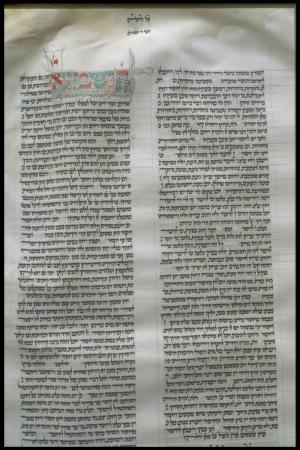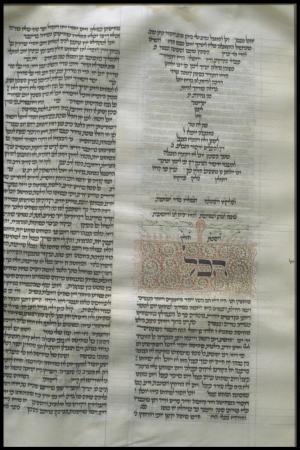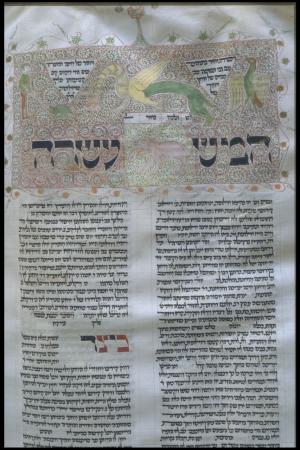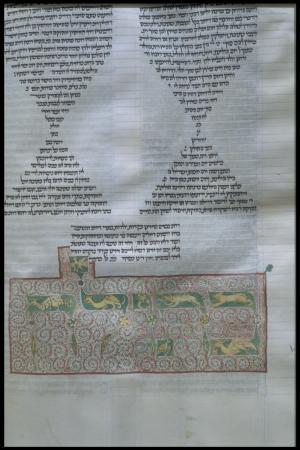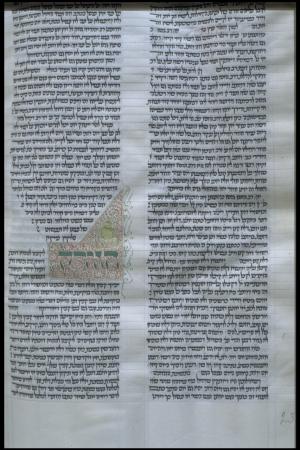Obj. ID: 1498
Hebrew Illuminated Manuscripts Vienna Sefer Mordecai, Austria, 1392
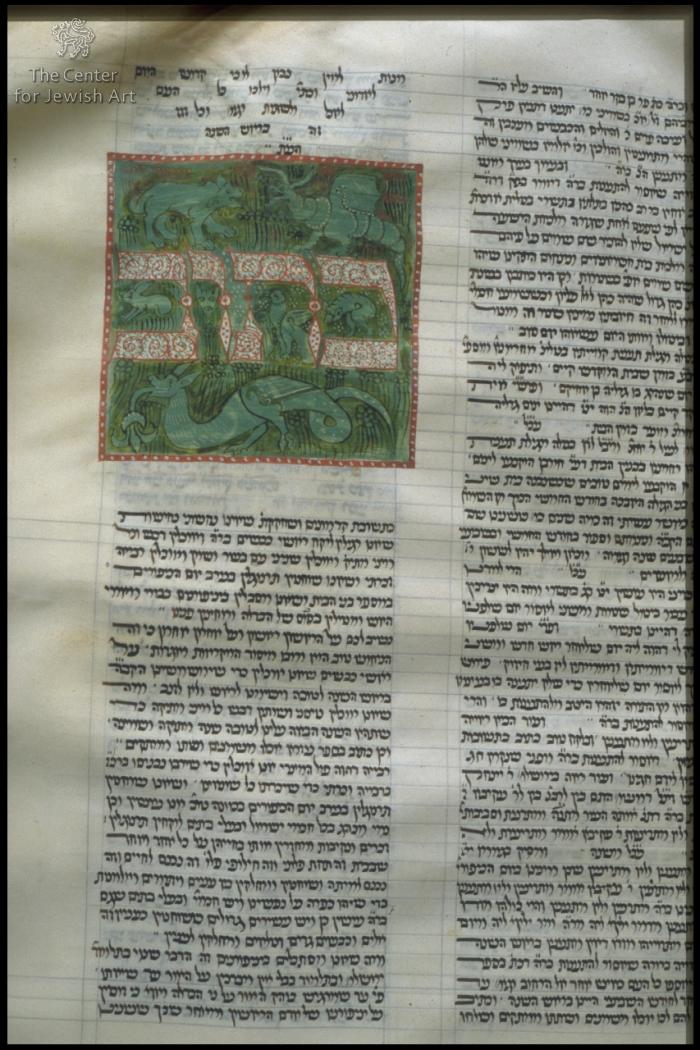
The Vienna Sefer Mordecai was copied in Germany or Austria in 1392 by three different scribes; one who copied the first two quires and two other scribes who shared the rest of the text between themselves: Barukh who copied the 3rd to the 22nd quires and Shalom who copied the last nine quires of the manuscript. In fact, Barukh started to copy the text on the first page of the 23rd quire but for reasons unknown, Shalom replaced him in his work and moved this quire to the end of the manuscript (Barukh's text appears on fol. 242) and started to copy the same text on a new quire, now the 23rd quire (see: Contents, above) and continued from that point on until the end of the manuscript. Shalom also signed the manuscript with a colophon which states that he copied the manuscript for Shemarya ben Moshe on March 9th, 1392.
This Sefer Mordecai is a later copy of an halakhic compendium by Mordecai ben Hillel Ha-Kohen (1240(?) - 1298), author and rabbinic authority in Germany, who died in Nuremberg a martyr’s death in the Rindfleisch massacres, together with his wife and five children. Mordecai’s fame rests on this Sefer Mordecai, always referred to as “The Mordecai.” This gigantic compendium consists of elaborations on Talmudic problems in the style of the tosafot.
“The Mordecai” spread quickly and many manuscripts were produced with this text. The history of the spread of "the Mordecai" and the transmigrations of its many versions in manuscript and in print is one of the most complicated in all rabbinic literature. Because of the book’s tremendous scope, two main compilations of extracts, the “Austrian” and the “Rheinish”, were made from it within a few decades, mainly reflecting regional laws and customs, and differing greatly from one another. The Rheinish version includes the views of many French and English scholars, and the customs of the German communities. These customs had spread eastward as far as Poland, but were not accepted west of Germany. The Austrian version reflects the minhag of southeastern Europe including the customs of Austria, Hungry, Bohemia, Saxony, and Moravia, and mentions many Austrian scholars. According to research on some of the tractates of Sefer Mordecai (Bava Kamma, Rosh ha-Shana, Yom Kippur, Sukkah, Bezah, Ta’anit and Megillah) in various manuscripts, and amongst them, our manuscript, scholars came to the conclusion that our manuscript belongs to the Austrian version (Sefer Mordecai Ha-Shalem, Mif'al Torat Hokhmei Ashkenaz, Mahon Yerushalayim,(Teachings of the Torah Sages of Ashkenaz), a Project of the Jerusalem Institute. 1989, 1992, 1995, 1997).
The Vienna Sefer Mordecai is lavishly illuminated with many decorated initial words and with some rich panels (see: Decoration Program, above). This is a typical to many other manuscripts of Sefer Mordecai of this period and region that we know of, which are mostly not illuminated or include simple decoration around the initial words only e.g. Sefer Mordecai, E. France, Besancon, 1397 (Cambridge - University Library Add. 490, 1), Sefer Mordecai, Ashkenaz, 1403 (Paris, Ecole Rabbinique 39), Sefer Mordecai, Ashkenaz, 1418 (Paris, Bibliotheque Nationale, heb. 407), Sefer Mordecai, Ashkenaz, 1459 (Toronto, University of Toronto, Ms Friedberg 5-011) and two Sefer Mordecai, Ashkenaz, after 1500 (Oxford, Bodleian Library Ms Mich. 582, 583). However, we know of another Sefer Mordecai that is also highly illuminated probably produced in Vienna, in 1373/4 (Budapest, Budapest, Szèchènyi Nationalbiblioteck, Cod. Hebr. 1; see: Fingernagel, Niederösterreichischen Randleistenstils). Like the Vienna Sefer Mordecai, the Budapest manuscript has a similar decoration program with decorated initial word panels for every opening of a tractate and with smaller panels for opening of subtitles. The panels of the tractates in the Budapest manuscript however, are more elaborate and include burnished gold letters within very large panels and also include a frame for the entire column. Thus we can conclude that most important illuminated examples of Sefer Mordecai are the Vienna Sefer Mordecai and the Budapest Sefer Mordecai, both produced in the last decades of the 14th century.
Stylistically the initial word panels in our manuscript on fols. 208v and 221v should be compared with a similar panel of another halakhic text, the SeMaK, produced in Nuremburg in 1392 (London, British Library, Add. 18684, fol. 12). In both manuscripts the initial words are filled with animals and foliate motives, commonly appearing in Ashkenazi manuscripts (see for example: ÖNB, Cod. Hebr. 163, fol. 2v, cat. XXX), however in both manuscripts the letters set within a panel are filled with a unified background of repeated pattern (in the Vienna manuscript with scrolls while in the Nuremburg SeMaK with flowers). Similar panels, in motives but not is style, with a unified background of large scrolls and repeated patterns can also be found in the Erna Michael Haggadah, Germany (Middle Rhine), ca. 1400 (Israel Museum, 180/58, fol. 35v). The decoration of the Erna Michael Haggadah (fols. 52v, 65v) could also be compared to the monochrome panels of theVienna manuscript on fols. 56, 58v and59. In both manuscripts dragons, hybrids and humans, depicted on a monochrome background, almost merge with the background.
Some initial words in our manuscript are decorated with dragons (fols. 56, 59, 97) or with a man fighting a dragon (fols. 58v, 65v, 208v), similar to the binding decoration.
sub-set tree:
Parchment; 243 leaves (the first leaf is not foliated and served as a flyleaf; the last folio also served as a flyleaf and foliated 242). It is hard to distinguish between hair side and flesh side.
Measurements
|
Full page: (490-510) x (350-366) mm |
|
Main text in two columns: Scribe A: (fols. 1v-13v): (305-323) x (207-210) mm Scribe B: Barukh (fols. 14-173v and fol. 242): (308-316) x (205-208) mm Scribe C: Shalom (fols. 174-241v): (313-317) x (204-210) mm |
|
Column’s width: Scribe A: 90-96 mm Scribe B: Barukh: 90-94 mm Scribe C: Shalom: 90-92 mm |
|
|
Scribes
Multi
|
Scribe A: |
Main text |
Fols. 1v-13v |
|
Scribe B: Barukh |
Main text |
Fols. 14-173v and fol. 242 |
|
Scribe C: Shalom |
Main text |
Fols. 174-241v |
Script
|
Main text written in semi-cursive Ashkenazi script in dark brown ink with red rubrics by the three hands. |
Number of columns:
The text is written in two columns.
Number of lines
|
Main text: Scribe A: Scribes B and C: |
49-51 lines per column 51 lines per column |
Ruling
Ruling by plummet, 52 horizontal (usually 3 lines on top, 2 at the middle and 3 at the bottom are ruled the full width of the page) and 1+2+1+2+2+1 vertical lines.
Pricking
Pricking is discernible in all margins.
Quires
31 quires of 8 leaves each except for II8-2 (fols. 8 & 9 are widows, with stub of fol. 8 is discernable between fols. 13-14; Text is missing between fol. 13v to 14); XXIX 8-1 (fol. 223 is a widow, with stub between fols. 227-228).
XXXI 8-2, (The first leaf of the quire (fol. 237) and the last leaf (fol. 242) are a bifolium; and so are fols. 240-241- bifolium; fols. 238 & 239 are widows. It seems that originally Scribe B copied that text on fol. 174, which opened a new quire. For unknown reasons, Scribe C replaced Scribe B and moved the quire already started by Scribe B, to the end of the manuscript and started to copy the same text on fol. 174 on another new quire. The sheet of the quire with the hand of Scribe B was folded to the other side. This refolding brought the first leaf (including the text of Scribe B) to be the last in the quire, thus fol. 242 which served as a pastedown. The 2nd (fol. 238) and 3rd (fol. 239) leaves of this quire are single leaves and their counterpart were blank and therefore cut-off.
Catchwords
Vertical and some horizontal catchwords to the quires appear in the lower left-hand corner of the final versos of each quire. Catchwords for the first three leaves of each of Scribe C's quires (XXIII-XXXI) are written horizontally at the lower left-hand margin of the verso side of those leaves (e.g. quire XXIII, fols. 174v, 175v, 176v, quire XXVI, fols. 198v, 199v, 200v).
Hebrew numeration
Some remnants of Hebrew alphabetical numeration - aleph to dalet - appear in the lower left-hand corner – very close to the edge - of the rectos of the first four leaves of some quires of Scribe B (III-XXII): e.g. quire X, fols. 70-74, quire XI, fols. 79, 81, quire XII, fols. 87-88 and quire XVII, fols. 126 and 128.
Blank leaves
Fol. 1R.
See binding document
The decoration was rendered by one artist.
A. Nine large initial word panels: 4 monochrome initial word panels opening three tractates (fols. 56, 59, 97) and a chapter (fol. 58v). The panels are in shades of light blue (fol. 58v, 59), green (fol. 56) and red (fol. 97) with black and white contours and decorated with dragons, hybrids and a hunting scene. Each panel occupies one column’s width. 5 penwork initial word panels opening 5 tractates, two of which are elaborate and occupy the two text column’s width decorated with dragons and hunting scenes (fols. 208v, 221v) while 3 others are smaller and extends to one column’s width only (fols. 180v, 191, 235v). These panels are filled with large red or green scrolls except fol. 235v which has a chequered background.
B. Large initial words opening tractates are written in display script in black (e.g. fols. 74v, 123, 155, 161v, 172), red (e.g. fols. 14, 65v) or in alternating colours of red and green (e.g. fols. 76v, 84). Some are chequered in red on the black ground (e.g. fols. 28v, 40v, 48v, 53) others have additional decoration below with a man killing a dragon (fol. 65v) or with a dragon (fols. 76v, 84). Few initials are framed (fol. 1v) or surrounded by a wriggly line (e.g. fols. 14, 40v, 65v).
C. Small initial word panels opening sections decorated with penwork scrolls of palmette motifs in green (e.g. fol. 13v, 198v), red (e.g. fol.199) , green and blue (fol. 201v), red and green (e.g. fol. 207v, 210v) and red, green and blue (fol.185). The panel on fol. 232v is decorated with large red or green scrolls and a frog on top. Some of the panels are not finished (e.g. fol. 207v, lower initial).
D. Many small initial words in red (e.g. fols. 7, 38v, 41v, 74, 129, 164, 166, 216v), green (e.g. fol. 198), or in alternating black and red (e.g. fols. 2v, 32v), or green and red (e.g. fols. 101, 174, 214). Some are gothic letters (e.g. fol. 63v in alternated red and black (fol. 114).
E. Decorated ascenders for the letter lamed with a fleur-de-lys or half fleur-de-lys (e.g.fols. 137, 138, 146v).
F. Simple geometrical rosette in red and brown ink is at the upper margin on fol. 138.
G. The end of each tractate and of some paragraphs is written in a shaped text in form of a goblet (e.g fols. 28, 40, 48, 53, 59, 61, 63, 65v, 84, 123, 133, 160, 161v, 171v, 191, 216v, 221v), and a ball(e.g. fols. 74, 76v, 97). The text on the three last pages of the manuscript is written in the form of bottles (fols. 240v, 241, 241v). Scribal notes of the second scribe, in the margin are written in a form of a triangle (e.g. fols. 77) in some cases it is decorated in red and brown ink (e.g. 110v, 127).
H. Some ends of tractates are decorated with wriggly lines (e.g. fol. 28).
I. Simple geometrical rosette at the upper margin on fol. 138.


